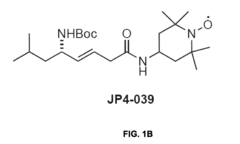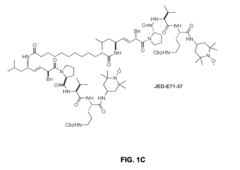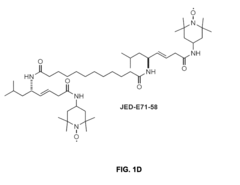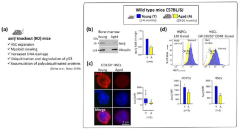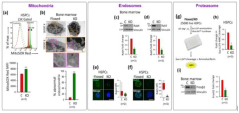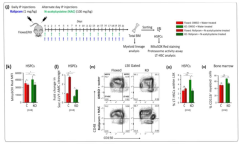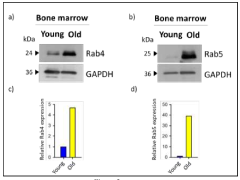Hypertonic Impacts on Aging: Emerging Research Directions
Hypertonic Aging Research Background
The field of hypertonic impacts on aging has emerged as a promising area of research in recent years, drawing attention from gerontologists, biologists, and medical professionals alike. This burgeoning interest stems from the growing understanding of the complex interplay between cellular osmotic balance and the aging process. Historically, research on aging has focused primarily on genetic factors, oxidative stress, and telomere shortening. However, the role of hypertonic environments in cellular senescence and organismal aging has gained traction as a novel perspective in the quest to unravel the mysteries of aging.
The concept of hypertonicity in biological systems refers to an environment where the concentration of solutes outside the cell is higher than inside, leading to water loss from the cell. This osmotic stress can have profound effects on cellular function, protein stability, and gene expression. Early observations of the impact of hypertonic conditions on cellular aging were made in the 1990s, but it wasn't until the early 2000s that systematic studies began to explore this phenomenon in depth.
Recent advancements in molecular biology techniques and high-throughput screening methods have accelerated research in this field. Scientists have discovered that hypertonic stress can induce premature senescence in various cell types, alter DNA repair mechanisms, and modulate the activity of key longevity-associated pathways such as sirtuins and mTOR signaling. These findings have opened up new avenues for understanding the fundamental mechanisms of aging and potential interventions to mitigate age-related decline.
The intersection of hypertonic research with other areas of aging biology has led to intriguing hypotheses. For instance, the accumulation of osmolytes in cells as a protective mechanism against hypertonic stress has been linked to protein aggregation, a hallmark of many age-related neurodegenerative diseases. Additionally, the role of hypertonic environments in epigenetic modifications and their potential transgenerational effects on aging have become subjects of intense investigation.
As the field progresses, researchers are exploring the therapeutic potential of manipulating cellular osmotic balance to combat age-related disorders. This includes developing novel compounds that can protect cells from hypertonic stress or harnessing the cellular responses to hypertonicity to activate longevity-promoting pathways. The implications of this research extend beyond basic biology, potentially impacting fields such as regenerative medicine, drug development, and personalized anti-aging therapies.
Market Analysis for Anti-Aging Solutions
The anti-aging market has experienced significant growth in recent years, driven by increasing consumer awareness of health and wellness, as well as a growing aging population worldwide. The global anti-aging market was valued at approximately $191 billion in 2019 and is projected to reach $422 billion by 2030, with a compound annual growth rate (CAGR) of 8.6% during the forecast period.
The market for anti-aging solutions encompasses a wide range of products and services, including skincare, hair care, cosmetic procedures, dietary supplements, and emerging technologies. Skincare products dominate the market, accounting for over 40% of the total market share. This segment includes anti-wrinkle creams, serums, and other topical treatments that promise to reduce visible signs of aging.
Geographically, North America holds the largest market share, followed by Europe and Asia-Pacific. The United States, in particular, is a key market for anti-aging solutions, with consumers spending billions annually on products and treatments. However, the Asia-Pacific region is expected to witness the fastest growth in the coming years, driven by rising disposable incomes, changing lifestyles, and increasing beauty consciousness among consumers in countries like China, Japan, and South Korea.
The demand for anti-aging solutions is primarily driven by the baby boomer generation, who are entering their senior years and seeking ways to maintain their youthful appearance and vitality. Additionally, millennials are emerging as a significant consumer group, focusing on preventive anti-aging measures and adopting skincare routines at an earlier age.
In recent years, there has been a shift towards more natural and organic anti-aging products, as consumers become increasingly conscious of the ingredients in their personal care items. This trend has led to the development of plant-based and clean beauty products that claim to offer anti-aging benefits without harmful chemicals.
The COVID-19 pandemic has had a mixed impact on the anti-aging market. While sales of certain products, such as facial skincare, experienced a decline due to reduced social interactions and mask-wearing, the overall focus on health and wellness has increased. This has led to a growing interest in holistic anti-aging approaches that address not only external appearance but also internal health and longevity.
As research into the biology of aging advances, new technologies and treatments are emerging in the anti-aging market. These include stem cell therapies, gene therapies, and personalized medicine approaches that aim to address the underlying causes of aging at a cellular level. The potential of hypertonic solutions in anti-aging treatments represents an exciting area of research that could open up new market opportunities in the coming years.
Current Challenges in Hypertonic Aging Studies
The field of hypertonic aging studies faces several significant challenges that impede progress and limit our understanding of the complex interplay between hypertonicity and the aging process. One of the primary obstacles is the lack of standardized protocols for inducing and measuring hypertonic stress in aging models. This inconsistency across research methodologies makes it difficult to compare and validate results from different studies, hindering the development of a cohesive body of knowledge.
Another major challenge lies in the complexity of the aging process itself. Aging involves numerous interconnected biological pathways and systems, making it challenging to isolate the specific effects of hypertonic stress. Researchers struggle to differentiate between the direct impacts of hypertonicity and the secondary effects that may arise from altered cellular functions or compensatory mechanisms triggered by hypertonic conditions.
The long-term nature of aging studies presents additional hurdles. Conducting longitudinal studies to observe the cumulative effects of hypertonic stress over extended periods is both time-consuming and resource-intensive. This limitation often forces researchers to rely on accelerated aging models or short-term studies, which may not accurately reflect the nuanced progression of aging under hypertonic conditions in real-world scenarios.
Furthermore, there is a notable gap in understanding the molecular mechanisms underlying the interaction between hypertonicity and aging. While some pathways, such as those involving osmolyte accumulation and cellular volume regulation, have been identified, the full spectrum of molecular changes and their long-term consequences remains largely unexplored. This knowledge gap hampers the development of targeted interventions to mitigate the negative impacts of hypertonic stress on aging.
Ethical considerations and limitations in human studies pose another significant challenge. Much of the current research relies heavily on animal models or in vitro cell cultures, which may not fully replicate the complexities of human aging. Translating findings from these models to human applications requires careful validation and often encounters unforeseen complications.
Lastly, the field faces technological limitations in accurately measuring and monitoring hypertonic conditions in living organisms over extended periods. Current methods for assessing osmolality and cellular responses to hypertonic stress often provide only snapshots of the physiological state, lacking the resolution to capture dynamic changes over time. Developing more sophisticated, non-invasive monitoring techniques remains a critical challenge for advancing hypertonic aging research.
Current Hypertonic Aging Interventions
01 Hypertonic solutions for preserving biological materials
Hypertonic solutions are used to preserve biological materials, such as cells, tissues, and organs, during storage and transportation. These solutions help maintain cellular integrity and viability by reducing water content and slowing down metabolic processes, thus extending the shelf life of biological samples.- Hypertonic solutions for preserving biological materials: Hypertonic solutions are used to preserve biological materials, such as cells, tissues, and organs, during storage and transportation. These solutions help maintain cellular integrity and prevent degradation, which is particularly important in the context of aging research and medical applications.
- Hypertonic solutions in aging-related diagnostics: Hypertonic solutions play a role in diagnostic techniques related to aging. They can be used to assess cellular responses, measure osmotic fragility, and evaluate age-related changes in various tissues and organs. These diagnostic applications contribute to our understanding of the aging process and age-related diseases.
- Hypertonic solutions for treating age-related conditions: Hypertonic solutions are employed in the treatment of various age-related conditions. They can be used to manage edema, improve wound healing, and address certain neurological disorders associated with aging. The osmotic properties of these solutions contribute to their therapeutic effects.
- Hypertonic solutions in anti-aging skincare: Hypertonic solutions are utilized in anti-aging skincare products. These solutions can help improve skin hydration, reduce the appearance of wrinkles, and enhance the delivery of active ingredients. The osmotic effects of hypertonic solutions contribute to their efficacy in addressing age-related skin concerns.
- Hypertonic solutions for cellular rejuvenation: Hypertonic solutions are explored for their potential in cellular rejuvenation and anti-aging therapies. These solutions may influence cellular metabolism, stress responses, and repair mechanisms, potentially contributing to the development of interventions that address age-related cellular decline.
02 Anti-aging effects of hypertonic solutions
Hypertonic solutions have been found to have potential anti-aging effects on skin and other tissues. These solutions can help improve skin hydration, reduce wrinkles, and promote cellular regeneration by inducing osmotic stress and activating cellular defense mechanisms.Expand Specific Solutions03 Hypertonic solutions in medical treatments
Hypertonic solutions are used in various medical treatments, including wound healing, reducing edema, and managing intracranial pressure. These solutions can help draw excess fluid from tissues, improve circulation, and promote faster healing in certain medical conditions.Expand Specific Solutions04 Formulation of hypertonic solutions for specific applications
The composition and concentration of hypertonic solutions can be tailored for specific applications in medicine, biotechnology, and research. Factors such as osmolarity, pH, and added components are optimized to achieve desired effects and minimize potential side effects.Expand Specific Solutions05 Long-term effects of hypertonic solutions on cellular aging
Research is ongoing to understand the long-term effects of hypertonic solutions on cellular aging and longevity. Studies investigate how controlled exposure to hypertonic environments may influence cellular stress responses, gene expression, and overall lifespan of organisms.Expand Specific Solutions
Key Players in Hypertonic Aging Research
The research on hypertonic impacts on aging is in an early developmental stage, with growing interest from both academia and industry. The market size is expanding as the global population ages, creating opportunities for innovative therapies. While the technology is still emerging, several key players are making significant strides. Companies like Alkahest, Inc. and Klotho Therapeutics, Inc. are focusing on novel approaches to combat age-related diseases. Academic institutions such as the Buck Institute for Research on Aging and the École Polytechnique Fédérale de Lausanne are contributing groundbreaking research. The involvement of pharmaceutical giants like Regeneron Pharmaceuticals, Inc. indicates the potential for rapid advancements in this field. The diverse range of organizations involved, from startups to established research centers, suggests a competitive landscape with ample room for technological breakthroughs and market growth.
Alkahest, Inc.
Buck Institute for Research on Aging
Breakthrough Hypertonic Aging Studies
- Administration of compounds containing TEMPO or 4-amino-TEMPOL functional groups, such as XJB-5-131, JP4-039, JED-E71-37, and JED-E71-58, which act as antioxidant and free radical scavengers, targeting mitochondria to reduce oxidative stress and delay aging-related symptoms.
- An in-vitro process involving the analysis of organelle-based biomarkers such as Rab4, Rab5, CoxIV, and Asrij/OCIAD1 in test samples compared to control samples to determine ageing, with potential modulation by molecules to reverse ageing phenotypes.
Regulatory Landscape for Anti-Aging Therapies
The regulatory landscape for anti-aging therapies is complex and evolving, reflecting the rapid advancements in hypertonic research and its potential impacts on aging. Regulatory bodies worldwide are grappling with the challenge of balancing innovation with safety and efficacy concerns in this emerging field.
In the United States, the Food and Drug Administration (FDA) plays a pivotal role in overseeing anti-aging therapies. The FDA has established guidelines for the development and approval of products that claim to have anti-aging effects, including those utilizing hypertonic solutions. These guidelines emphasize the need for robust clinical trials and scientific evidence to support any anti-aging claims.
The European Medicines Agency (EMA) has also been proactive in addressing the regulatory challenges posed by anti-aging therapies. The EMA has implemented a framework for the evaluation of advanced therapy medicinal products (ATMPs), which includes many potential anti-aging treatments. This framework aims to ensure that innovative therapies are rigorously assessed for safety and efficacy before reaching the market.
In Asia, countries like Japan and South Korea have taken steps to create more flexible regulatory pathways for anti-aging therapies. Japan's Pharmaceuticals and Medical Devices Agency (PMDA) has introduced an accelerated approval system for regenerative medicine products, which could potentially include certain anti-aging treatments.
Globally, there is a growing recognition of the need for harmonized regulatory approaches to anti-aging therapies. The International Conference on Harmonisation of Technical Requirements for Registration of Pharmaceuticals for Human Use (ICH) has been working towards developing common guidelines that could be adopted across different regulatory jurisdictions.
One of the key challenges in regulating anti-aging therapies is the definition of aging itself as a disease or condition. This classification has significant implications for how products are evaluated and approved. Some regulatory bodies are considering new categories or pathways specifically for anti-aging therapies that may not fit traditional drug or medical device classifications.
Ethical considerations also play a crucial role in shaping the regulatory landscape. Regulators must balance the potential benefits of anti-aging therapies with concerns about equity, access, and the societal implications of extended lifespans. This has led to ongoing debates about the appropriate regulatory frameworks for these emerging technologies.
As research into hypertonic impacts on aging continues to advance, it is likely that regulatory frameworks will need to evolve to keep pace. This may include the development of new guidelines for long-term safety monitoring, given the potentially extended duration of use for anti-aging therapies. Additionally, regulators may need to consider novel endpoints and biomarkers specific to aging processes when evaluating the efficacy of these treatments.
Ethical Considerations in Longevity Research
The ethical considerations in longevity research, particularly concerning hypertonic impacts on aging, are multifaceted and require careful examination. As scientific advancements push the boundaries of human lifespan, it becomes imperative to address the ethical implications that arise from these developments.
One primary ethical concern is the equitable distribution of longevity-enhancing technologies. If hypertonic treatments prove effective in slowing the aging process, there is a risk that access to such interventions may be limited to affluent individuals or nations. This could exacerbate existing health disparities and create a new form of social inequality based on lifespan potential.
The concept of informed consent also presents challenges in longevity research. Given the long-term nature of aging studies, it can be difficult to fully inform participants about potential risks and benefits that may only become apparent decades later. Researchers must develop robust protocols to ensure ongoing consent and the ability for participants to withdraw from studies as new information emerges.
Privacy and data protection are critical ethical considerations in this field. Longitudinal studies on aging often involve collecting vast amounts of personal health data over extended periods. Safeguarding this sensitive information from misuse or unauthorized access is paramount, especially as the value of such data increases with advancements in personalized medicine and AI-driven health analytics.
The potential for unintended societal consequences must also be carefully considered. Significant increases in lifespan could impact population dynamics, economic systems, and intergenerational relationships. Ethical frameworks must be developed to address these broader societal implications, including the potential strain on healthcare systems and pension funds.
Moreover, there are philosophical and existential questions to grapple with. As we extend human lifespan, we must consider the impact on the human experience of life and death. Ethical debates must explore whether dramatically extending life is inherently desirable and what it means for human identity and purpose.
Lastly, the responsible conduct of research in this field is crucial. Given the high stakes and potential for sensationalism, researchers must maintain rigorous scientific standards and resist pressure to overstate or prematurely announce results. Transparency in methodology and results, along with robust peer review processes, are essential to maintain public trust and ethical integrity in longevity research.

